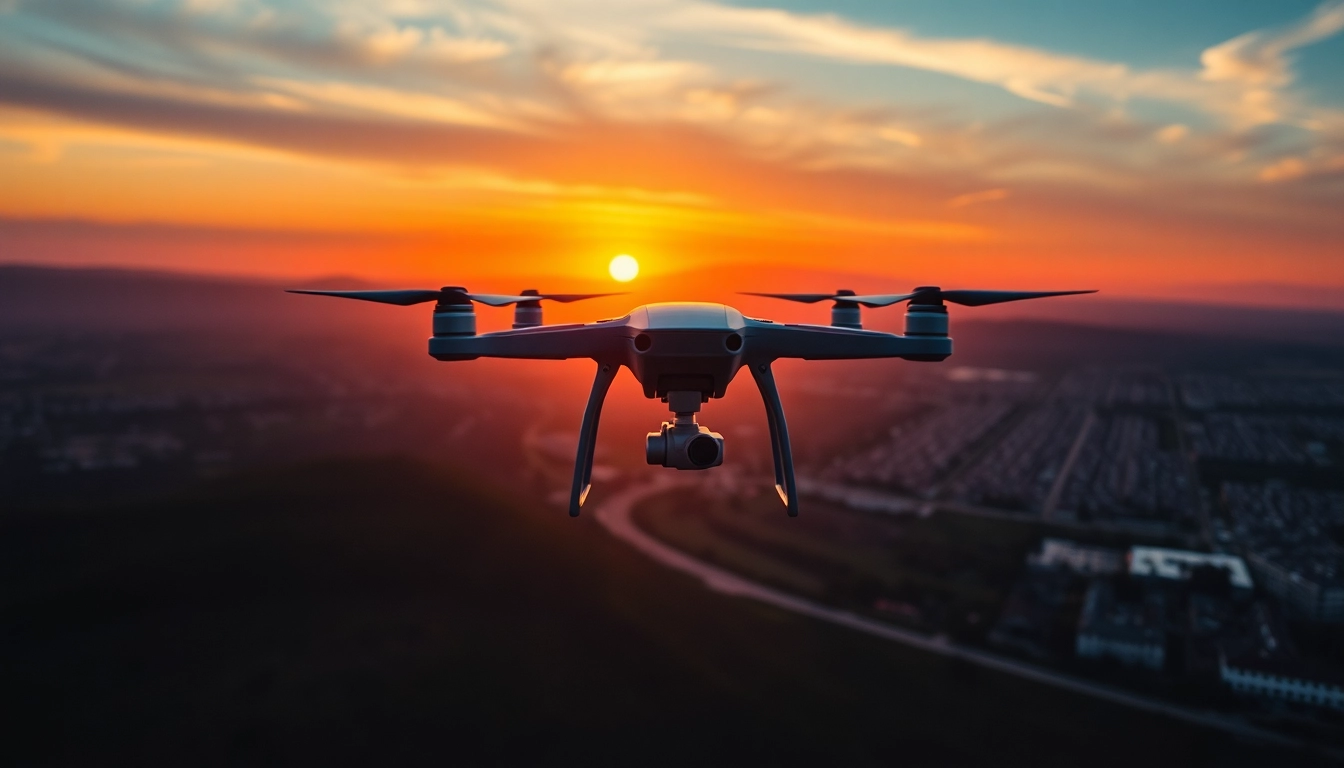Understanding Drone Photography Basics
What is Drone Photography?
Drone photography involves capturing images and videos from an aerial perspective using unmanned aerial vehicles (UAVs), commonly known as drones. This innovative method has revolutionized various fields, including real estate, tourism, agriculture, and wildlife observation. Drones are equipped with high-resolution cameras that can tilt and pan, allowing photographers to achieve dynamic angles and perspectives that are impossible with traditional photography.
As the technology behind UAVs has progressed, so has drone photography. With advanced stabilization features and sophisticated camera sensors, aerial imagery has transformed from basic snapshots into cinematic masterpieces. Therefore, understanding the nuances of drone photography is key for anyone looking to break into this exciting industry.
Essential Equipment for Beginners
The foundational aspect of starting a drone photography business is selecting the right equipment. Below are essential items you’ll need:
- Drone: Choose a drone that meets your needs; popular options for beginners include the DJI Mini series or the Mavic Air 2 for their balance of quality and ease of use.
- Camera: Ensure your drone is equipped with a high-quality camera. The more megapixels and better sensor your drone has, the clearer and more professional your photos will look.
- Extra Batteries: Drone batteries have limited flight times. Carrying extra batteries ensures longer shooting sessions.
- Memory Cards: Invest in high-speed memory cards that can keep up with the data being recorded to avoid lag or drop in quality.
- Filters: ND (Neutral Density) filters can help manage exposure levels during bright daylight shooting.
- Remote Controller: Most drones come with a controller that enhances your flying experience and provides greater control over your shots.
- Insurance: Consider getting drone insurance to protect your business and equipment from any unforeseen accidents or liabilities.
Regulations and Licensing for Drone Use
Pursuing drone photography requires adherence to specific regulations. In the United States, the Federal Aviation Administration (FAA) has established guidelines that you must follow:
- Part 107 Certification: To legally operate a drone for commercial purposes, you need a Part 107 Remote Pilot certificate, which involves passing a written test on aeronautical knowledge.
- Flight Restrictions: Be aware of airspace restrictions. You cannot fly within five miles of airports without notifying the air traffic control and obtaining necessary permissions.
- Weight Limitations: Drones weighing over 55 pounds must be registered with the FAA. Make sure your drone is compliant with these guidelines.
- Local Regulations: In addition to federal laws, check local laws that may impose stricter restrictions on drone operations.
How to Start a Drone Photography Business
Creating a Business Plan for Drone Photography
A solid business plan lays the foundation for your drone photography business. Start by clearly defining your mission statement and objectives. Here’s how to get started:
- Market Research: Identify your local market and competitors. Understanding what services are in demand allows you to tailor your offerings effectively.
- Service Offerings: Decide on the types of drone photography services you will offer and craft a unique value proposition that sets you apart.
- Financial Projections: Estimate your startup costs, operational expenses, and pricing model. This will help you forecast profitability and understand your break-even point.
- Marketing Strategy: Plan how to promote your business to reach your target audience. Consider digital marketing, networking, and partnerships.
Setting Up Your Brand and Online Presence
Creating a strong brand and establishing an online presence is crucial for attracting clients. Here are some strategies to consider:
- Brand Identity: Design a logo and choose brand colors that reflect your style. Be consistent across all platforms.
- Website Development: Build a professional website showcasing your portfolio, services, and contact information. Ensure it is mobile-friendly and SEO-optimized to reach potential clients.
- SEO Strategies: Optimize your website for search engines by incorporating keywords like how to start a drone photography business, writing quality content, and implementing link-building strategies.
- Social Media Engagement: Create accounts on platforms such as Instagram, Facebook, and LinkedIn. Share your work, engage with followers, and participate in community conversations relevant to drone photography.
Identifying Your Target Market
Successful drone photographers understand their target audience. Identify and segment your market into niches:
- Real Estate Agents: High-quality aerial photos can greatly enhance property listings.
- Event Planners: Drones can capture weddings and outdoor events from stunning perspectives.
- Tourism Agencies: Collaborate with local tourism boards to create promotional content for destinations.
- Agriculture: Farmers often require aerial views to assess crop health and manage land.
Building Your Drone Photography Portfolio
Choosing Projects for Showcase
Your portfolio is your ultimate sales tool. Focus on projects that best represent your style and skills. Here are tips for building a standout portfolio:
- Diverse Range of Work: Showcase various styles and subjects, from landscapes and urban areas to events.
- Personal Projects: If you lack client work, create personal projects that demonstrate your creativity and technical prowess.
- High-Quality Images: Include only your best work. Quality over quantity is essential in attracting potential clients.
- Case Studies: Provide brief descriptions accompanying each project, explaining the goals, challenges, and outcomes.
Effective Techniques for Shooting
Mastering drone photography techniques is critical for obtaining professional-quality results:
- Understanding Lighting: The golden hour—shortly after sunrise or before sunset—offers the best natural lighting.
- Composition Rules: Apply composition techniques like the rule of thirds, leading lines, and symmetry to enhance the visual appeal.
- Stability Control: Utilize stabilization features and modes on your drone to ensure smooth footage and clear images.
- Altitude and Angles: Experiment with different altitudes and angles to gain unique perspectives of your subject!
Editing and Post-Processing Your Photos
Post-processing is where raw images transform into eye-catching photographs. Familiarize yourself with editing software like Adobe Lightroom and Photoshop:
- Basic Edits: Adjust exposure, contrast, and saturation to enhance the overall look.
- Advanced Techniques: Master color grading and retouching techniques to elevate your photos.
- Use Presets: Create or purchase presets that align with your style to speed up your editing process.
- Seek Feedback: Join photography communities to share your edited work and receive constructive criticism.
Marketing Strategies for Drone Photography
Online Marketing Techniques
Building an online presence is essential for reaching clients who are actively looking for drone photography services. Here are effective online marketing strategies:
- Content Marketing: Write blog articles or create videos on topics related to drone photography to establish authority and attract organic traffic.
- Email Marketing: Collect email addresses from interested clients and send newsletters featuring your latest work, news, and promotions.
- Online Directories: List your business on platforms like Thumbtack and Yelp to gain visibility among local clients.
Networking with Local Businesses
Networking is crucial for finding clients and collaborations. Here are ways to connect with local entities:
- Attend Local Events: Participate in community fairs, trade shows, and networking events to meet potential clients.
- Collaborate with Other Professionals: Partner with real estate agents, event planners, and marketing agencies for joint projects.
- Join Local Groups: Engage with local business associations or photography clubs for networking opportunities.
Utilizing Social Media for Engagement
Social media can effectively showcase your work and engage with potential clients. Here’s how:
- Consistent Posting: Regularly update your profiles with new work and behind-the-scenes content.
- Engagement: Respond to comments and messages promptly to foster relationships with followers.
- Run Contests or Promotions: Encourage shares and engagement by hosting contests for free photography sessions or prints.
- Utilize Hashtags: Use relevant hashtags to increase visibility and reach a broader audience.
Measuring Success and Growth in Your Drone Business
Key Performance Indicators to Track
Measuring success goes beyond the number of clients. Keep track of the following key performance indicators (KPIs):
- Customer Acquisition Cost: Determine how much it costs you to acquire a new client. This can help in assessing the effectiveness of your marketing strategies.
- Revenue Growth: Monitor your income over time to identify trends and determine your business trajectory.
- Client Retention Rate: Understand how many of your clients return for repeat services, indicating satisfaction with your work.
- Engagement Rates: Analyze engagement on social media platforms to measure the effectiveness of your content.
Customer Feedback and Continuous Improvement
Receiving client feedback is crucial for growth. Consider implementing the following strategies:
- Follow-Up Communication: After completing a project, reach out to clients for their thoughts on the work and how your services can improve.
- Online Reviews: Encourage satisfied clients to leave positive reviews on your website or social media profiles.
- Surveys: Conduct surveys to gain insights on client preferences and experiences.
Expanding Services and Client Base
As your business grows, consider expanding your offerings to attract a broader range of clients:
- New Services: Investigate opportunities like editing services, consulting for drone users, or offering courses in drone photography.
- Diverse Industries: Branch out to work with different industries, including construction, insurance, or environmental agencies.
- Geographical Expansion: Explore opportunities in neighboring cities or states as you grow your brand recognition.


